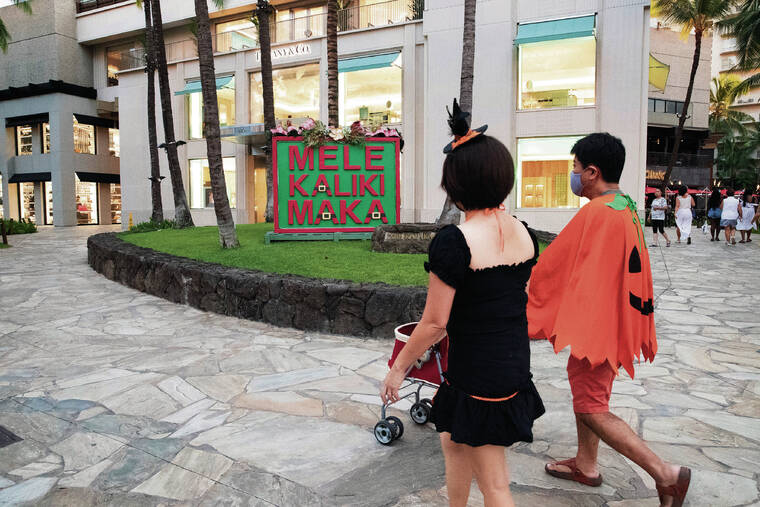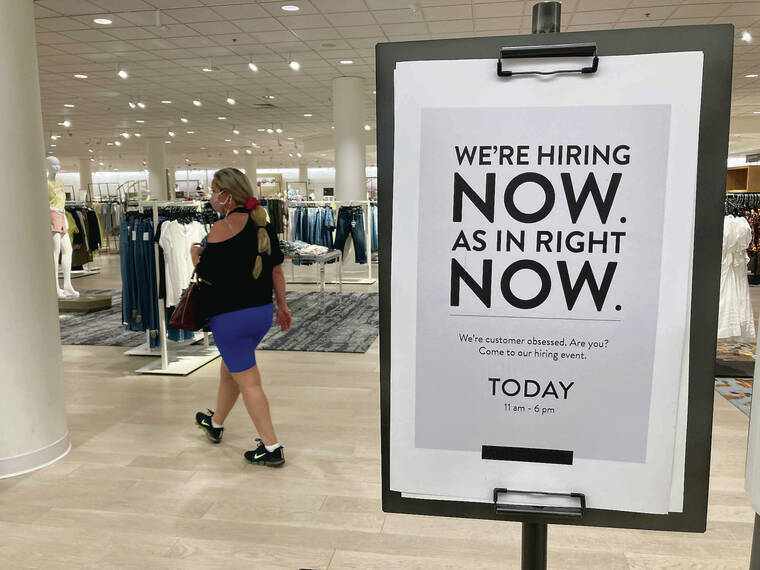It’s beginning to look a lot like Christmas in Hawaii, with some retailers putting out holiday decorations and launching Black Friday sales promotions even before Halloween.
There is an expectation that shoppers, who have spent many money-saving months locked down during the pandemic, are champing at the bit to get out and spend. But there’s also a worry that the benefits to retailers from increased consumer urges could be tempered by labor shortages and lingering supply-chain issues.
Rising inflation, which means shoppers’ dollars don’t go as far as in the past, is also a concern.
On Wednesday the National Retail Federation forecast that holiday sales during November and December will grow between 8.5% and 10.5% over 2020 to between $843.4 billion and $859 billion, the highest holiday retail sales on
record. That compares with a
previous high of 8.2% in 2020 to $777.3 billion and is well over an average increase of 4.4% during the past five years.
The NRF also forecast that online and other nonstore sales will increase between 11% and 15%
to a total of $218.3 billion to
$226.2 billion — up from $196.7 billion in 2020.
“There is considerable momentum heading into the holiday shopping season,” said NRF President and CEO Matthew Shay in a statement.
“Consumers are in a very favorable position going into the last few months of the year as income is rising and household balance sheets have never been stronger,” Shay said. “Retailers are making significant investments in their supply chains and spending heavily to ensure they have products on their shelves to meet this time of exceptional consumer demand.”
Black Friday, traditionally the day after Thanksgiving, once marked the start of the holiday shopping season. But Tina Yamaki, president of Retail Merchants of Hawaii, said many Hawaii retailers are starting far earlier this year.
“Some retailers started Black Friday sales in October or Nov. 1,” Yamaki said. “Those that are doing a traditional Black Friday sale may offer it for a weekend or for the whole week.”
Tanna Dang, owner of the Eden in Love boutique she founded in 2007 with her husband, Bryson Dang, saw the wisdom of transitioning to a fully online store in 2020 when the pandemic forced them to reevaluate their plans for a holiday pop-up store.
“In 2019 we had our biggest pop-up store and had 800 sales in 16 hours,” she said. “We had planned another pop-up in 2020 but went online because of the pandemic. We had 1,001 sales in the first 15 minutes and over 3,500 sales for the whole day.”
Dang said the couple moved out of their International Market Place store just before the pandemic, shut down their Las Vegas shop on Saturday and plan to close their South Shore Market location in
Kakaako in January.
“We had to figure out how to sustain ourselves when we were closed,” she said. “We could have just as many sales when we were sleeping. My dad was sad that we were closing our Las Vegas store. But I told him not to be sad, that it’s part of our story, part of our journey. Online is really working
out for us.”
The holiday shopping season seems to start earlier each year, Dang said, and she anticipates that pandemic shoppers will be even more primed to begin.
“The pandemic has left people looking for joy and comfort and connection,” she said. “People will buy gifts to create a connection and to give them a reason and a purpose to meet up with family and friends.”
Sam Shenkus, vice president and director of marketing for the Royal Hawaiian Center, said the center likes to keep to a traditional holiday retail schedule. Still, Royal Hawaiian Center
decorates early, which might serve as a reminder to shoppers about how quickly the holidays are coming.
Shenkus said the festive trimmings started going up in October to ensure that all three blocks are decorated by the day before Thanksgiving, when Santa arrives at the center in a trolley.
“We don’t light the displays or the 34-foot tree
until the night before Thanksgiving,” Shenkus said. “We don’t have that many Black Friday items. But we do offer free pictures with Santa, and many of our stores offer limited-edition inventory that you can’t get anywhere else. We focus on the environment and the experience.”
Yamaki said there are plenty of reasons retailers want shoppers to start
earlier this holiday season. A good pre-pandemic holiday season might have meant the difference between ending the year in the red or the black, Yamaki said, but now “it’s live-or-die time.”
“The holiday season is like the Super Bowl for retailers,” she said. “This year it’s even more important than in the past, as a majority of retailers are riding on the holidays.”
Yamaki said Oahu retailers were closed down twice during the pandemic, and during the last shutdown they couldn’t even do online sales unless it was from home.
“During the shutdowns, retailers had to pay commercial rent, utilities and other operational costs. Some had their rent deferred, and there are big balloon payments due,”
she said.
A few businesses are doing well, but retailers that depend on visitors are still struggling, Yamaki said.
“While some visitors have returned, they are more budget-oriented,” she said. “It’s the ‘McVisitor.’ They don’t stay in hotels; they don’t buy much retail; they split a plate lunch instead of going out to eat; they buy one cookie for each person instead of a box to take home.”
Yamaki said another reason for the early start is that retailers know orders might take longer to fill due to supply-chain challenges. There were already waits for assistance at bricks-and-mortar stores before the holiday rush, and now because of labor shortages, she said, some retailers may not be able to offer as many extended holiday hours as in the past.
The global supply chain has been buffeted by a multitude of problems, from factories having to close due to COVID-19 surges, a lack of containers to ship items in, backups at ports and warehouses, and a shortage of truckers.
Meanwhile, prices are
rising due to a surge in shipping costs. At this time in 2020, ocean freight rates from China to the U.S. West Coast were $3,847 per 40-foot container. Now the same container will cost $17,377 to ship, according to Freightos, a Hong Kong-based online freight marketplace.
Yamaki said all of these issues, coupled with Hawaii’s labor shortage, “creates the perfect storm.”
Job openings are already plentiful, allowing job-seekers to be pickier about where they work. There were 10.4 million job openings at the end of August and 11.1 million openings the month before, the highest on record since at least December 2000, when the government started recording that figure.
At the same time, the Labor Department said, the number of people quitting their jobs jumped to 4.3 million in August, up from
4 million in July.
Some wonder whether employers that need holiday help will be able to find workers in time.
“It doesn’t look good,” said Andrew Challenger, senior vice president at hiring firm Challenger, Gray &Christmas, which predicts retailers will add 700,000 workers during the holidays this year, 36,000 fewer than in 2020.
At the employment website Indeed, searches by people looking for seasonal work were down 13% the week ending Oct. 10, compared with the same period a year ago. And those searches were down 27% from 2019, before the pandemic began.
“The job-seeker interest is sluggish,” said AnnElizabeth Konkel, an economist at Indeed. “It’s just not taking off.”
If Hawaii’s retailers can’t get the help they need,
Yamaki said, they will have to rely more heavily on the current workforce, increasing the possibility of employee burnout or that overtime pay will cut into profits.
Craig Rowley, who works at the retail and consumer goods team at management consulting firm Korn Ferry, said if employers can’t find the workers they need,
online orders could take longer because there won’t be enough people to pack orders or deliver them, especially as it gets closer to Christmas and more shoppers head online.
And stores are likely to do away with late-night or overnight hours since retailers will want their existing staff to work when stores are busiest.
“You’re not going to see the wild extended hours because they just can’t staff it,” Rowley said.
———
The Associated Press
contributed to this story.




